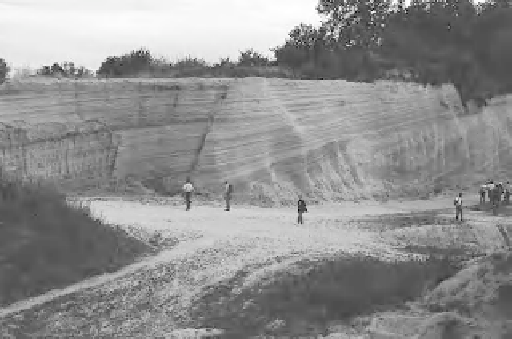Geology Reference
In-Depth Information
Figure 13.4.
An exposure of stratifi ed slope deposits (“grèzes litées”), near Sonneville, Charente
region, southwest France.
lower valley-side slopes. In Charente, the stratifi ed sediments consist of small angular
limestone particles, up to 2-3 cm in diameter, together with inter-layered fi ner fractions.
These materials, and their stratifi cation, refl ect frequent, probably diurnal, oscillations of
freezing and thawing. The sorting, bedding, eluviation, and redeposition of fi ner particles
are all attributed to slopewash following the melt of ice and snow. Bedded scree is a form
of stratifi ed-slope deposit found in upland areas (Boardman, 1978; Derbyshire, 1973;
Karte, 1983).
The apparent absence of similar deposits from most high latitudes can probably be
explained by the relative lack of repeated freeze-thaw oscillations in high latitudes (see
Chapter 3). The closest present-day analogue is the stratifi ed scree described from the
sub-arctic region of Gaspésie, Eastern Canada (Hétu, 1995; Hétu et al., 1994). There,
stratifi cation is achieved by the sliding of icy block fragments over each other on the slope
in winter together with niveo-eolian processes in spring. Another analogous mechanism,
especially appropriate for high-mountain relief in low latitudes, is a combination of
solifl uction and mudfl ow/eluviation following snowmelt and active-layer thaw in spring
(Francou, 1988, 1990).
In summary, stratifi ed-slope deposits should be regarded as having some qualitative
cold-climate signifi cance. However, it must also be borne in mind that similar deposits
may refl ect sedimentological mechanisms, such as dry-grain fl ow and debris fl ow, which
are unrelated to periglacial conditions (Hétu et al., 1995; Van Steijn et al., 1995).
13.2.4. Head and Solifl uction Deposits
The slow mass-wasting processes that occur on slopes in cold climates today have been
described in Chapter 9. Given the importance of freeze-thaw activity in the Pleistocene
mid-latitudes, many unstratifi ed and heterogeneous materials which mantle lower slopes
and valley bottoms are regarded as the mid-latitude equivalents of the solifl uction and
“muck” deposits that formed in the high latitudes during the Pleistocene (see Chapter 11).
These deposits were fi rst reported from southwest England, where they were termed
“head” since they rested on the top of many coastal cliff sections (De la Beche, 1839).
Later, C. Reid (1887) described the “coombe rock” of the Chalkland valleys as a form of

